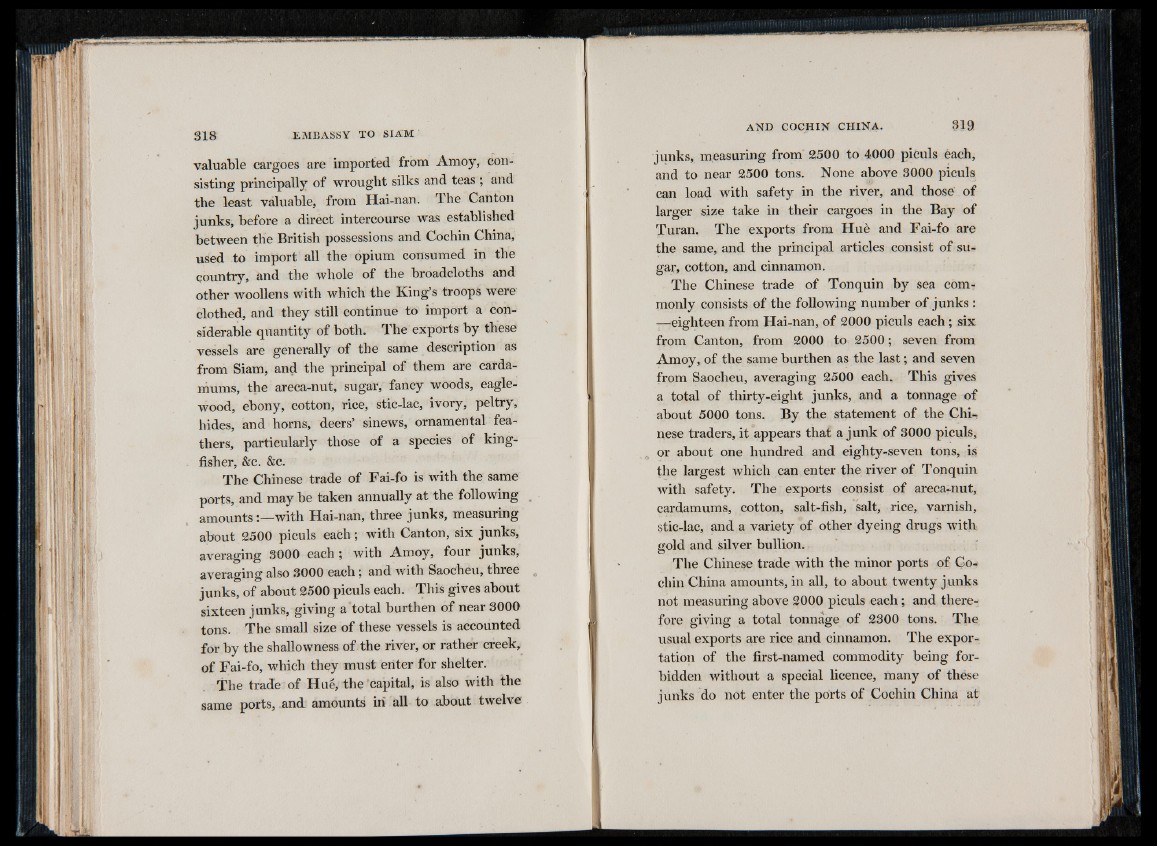
valuable cargoes are imported from Amoy, consisting
principally of wrought silks and teas ; and
the least valuable, from Hai-nan. The Canton
junks, before a direct intercourse was established
between the British possessions and Cochin China,
used to import all the opium consumed in the
country, and the whole of the broadcloths and
other woollens with which the King’s troops were
clothed, and they still continue to import a considerable
quantity of both. The exports by these
vessels are generally of the same description as
from Siam, and the principal of them are carda-
mums, the areca-nut, sugar, fancy woods, eagle-
wood, ebony, cotton, rice, stic-lac, ivory, peltry,
hides, and horns, deers’ sinews, ornamental feathers,
particularly those of a species of kingfisher,
&c. &c.
The Chinese trade of Fai-fo is with the same
ports, and maybe taken annually at the following
am o u n t sw i th Hai-nan, three junks, measuring
about 2500 piculs each; with Canton, six junks,
averaging 3000 each ; with Amoy, four junks,
averaging also 3000 each ; and with Saocheu, three
junks, of about 2500 piculs each. This gives about
sixteen junks, giving a total burthen of near 3000
tons. The small size of these vessels is accounted
for by the shallowness of the river, or rather creek,
of Fai-fo, which they must enter for shelter.
The trade of H u e , the capital, is also with the
same ports, and amounts in all to about twelve
junks, measuring from 2500 to 4000 piculs each,
and to near 2500 tons. None above 3000 piculs
can load with safety in the river, and those of
larger size take in their cargoes in the Bay of
Turan. The exports from Huè and Fai-fo are
the same, and the principal articles consist of sugar,
cotton, and cinnamon.
The Chinese trade of Tonquin by sea commonly
consists of the following number of junks :
—-eighteen from Hai-nan, of 2000 piculs each ; six
from Canton, from 2000 to 2500 ; seven from
Amoy, of the same burthen as the last; and seven
from Saocheu, averaging 2500 each. This gives
a total of thirty-eight junks, and a tonnage of
about 5000 tons. By the statement of the Chi--
nese traders, it appears that a junk of 3000 piculs,
or about one hundred and eighty-seven tons, is.
the largest which can enter the river of Tonquin
with safety. The exports consist of areca-nut,
cardamums, cotton, salt-fish, salt, rice, varnish,
stic-lac, and a variety of other dyeing drugs with
gold and silver bullion.
The Chinese trade with the minor ports of Cochin
China amounts, in all, to about twenty junks
not measuring above 2000 piculs each ; and therefore
giving a total tonnage of 2300 tons. The
usual exports are rice and cinnamon. The exportation
of the first-named commodity being forbidden
without a special licence, many of thèse
junks do not enter the ports of Cochin China at